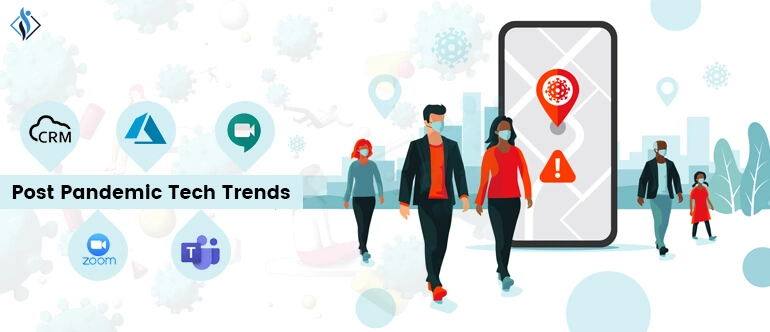Home » Technology News » How Post Pandemic Tech Trends Will Transform Workplace Operations?
How Post Pandemic Tech Trends Will Transform Workplace Operations?

In the last couple of months, the COVID-19 outbreak has completely changed the way businesses used to operate in the past. Due to the pandemic, many businesses had to either completely shut down their operations or adapt to new working cultures that were still underway in the normal pre-pandemic world.
For instance, the trend of virtual meetings accelerated significantly as the majority of companies started following the “work from home” culture. In a nutshell, the COVID-19 outbreak has accelerated the adaptation of several emerging technologies that might have taken a few more years to come into the picture.
So, in this guide, we’re going to walk you through a top 6 post-pandemic technology trends that will last even when the COVID-19 pandemic is in the rearview mirror.
Emerging Technology Trends in Post-Pandemic Workplace
- Virtual Meetings & e-Learning Apps
- Cloud Services
- Telehealth & Telemedicine Services
- Digital CRM – Insurance Policy Transactions
- Need for Cybersecurity
- Rapid Deployment of 5G Networks
- Healthcare Sector Transformation
1. Virtual Meetings & e-Learning Apps
Video Conferencing Apps
Considering the impact of the COVID-19 outbreak, several countries imposed a nation-wide lockdown to restrict the virus from spreading further.
During this isolation period, apps like Google Meet and Zoom encountered a sudden increase in the number of users as many businesses started using them to conduct virtual meetings with employees as well as their global clients.

In fact, in April 2020, the Zoom app surpassed the 300 million daily meetings benchmark, which is way higher than the 10 million meetings recorded in December 2019. Back in April, even Google made “Google Meet” free for users with a G Suite account with a limitation of 100 participants per meeting.
Now, even after countries lift the lockdown and the entire COVID-19 pandemic ends, the trend of virtual meetings is most likely to continue for several years. Why? Because it will still take a few more years for international travel to become normal again.
In such a scenario, conference meeting apps will be the ultimate tool to conduct meetings and conferences globally. This also means that the demand for virtual meeting apps will grow and as a result, virtual meeting apps development will become a booming sector.
e-Learning Apps
The COVID-19 outbreak has created worldwide chaos in a relatively short period and education institutes, across the globe, are forced to shut down completely.
Today, students, as well as teachers, are stuck in a situation where they have to shift from the conventional way of learning/teaching to the new “e-learning” trend.

While e-learning was getting popular even in the pre-pandemic world, the nationwide lockdown has surged the adaptation rate significantly. As a result, video conferencing apps like Google Meet and Zoom have witnessed a sudden increase in the number of users and daily meeting sessions.
Considering the current scenario and daily COVID-19 reports, it’s safe to say that e-learning is most likely to continue for several months.
However, experts even believe that we can expect “online classes” to become a norm in the education market even when the pandemic ends. Of course, e-learning can’t replace the regular way of schooling completely, mainly because it has its own sets of challenges.
For instance, it’s extremely challenging for a student to build the required concentration to attend a class while sitting in the comfort of his home. Similarly, it becomes strenuous for the tutor to convey the lecture while navigating through different controls of the video conferencing app.
In a nutshell, to make e-learning a mainstream trend, the education industry needs to develop the required infrastructure that can overcome these challenges and help students learn effectively.
2. Cloud Services
Among all the sectors that witnessed a sudden growth due to the pandemic, the cloud computing industry remains at the top.
Maintaining social-distancing norms and implementing remote working has forced different organizations to rely on cloud services to manage different operations including analytics, file storage, conferencing, and even product testing.
As a result, the demand for cloud services has increased exponentially in the past three months. To believe Microsoft, the tech-giant has witnessed a 775% surge in its cloud services like Microsoft Teams and Windows Virtual Desktop in Italy within a period of one month.
With the COVID-19 outbreak, one thing has become extremely clear, i.e., cloud services can minimize the risks of complete shutdown, even when an unexpected crisis like Coronavirus attacks the entire world.
During the outbreak, companies that were already reaping the benefits of cloud-computing had to face fewer or zero issues while shifting to the remote work culture.
On the other hand, organizations that weren’t using cloud services had to immediately adopt the technology, which made the entire shift a bit of hassle.
Since businesses have already understood the long-lasting benefits of cloud services, it’s no secret that they’re going to invest heavily in cloud-computing to improve their existing cloud-infrastructure and build custom cloud-native apps once the pandemic ends.
3. Digital CRM – Insurance Policy Transactions
Another tech trend that will boom after the pandemic is the change in insurance policy transactions.
- As per conventional practices, every healthcare insurance policy transaction requires face-to-face interaction as the agent needs to meet the individual personally and collect all the required documents.
- However, this practice started to fail miserably as soon as people started working remotely during the lockdown. Since social distancing became extremely important, agents weren’t able to sell as many insurance policies as earlier.
This has made insurance companies realize the benefits of feature-rich Insurance CRM solutions. These types of applications allow the end-user to purchase a healthcare insurance policy online without having to meet an agent whatsoever.
Even the required documents can be submitted remotely using such tools. While there are very few Insurance CRM applications, we are most likely to see a sudden increase in the demand for such applications.
Related Read: Complete Guide for Insurance CRM Software & Agency Sales CRM
4. Telehealth & Telemedicine Services
If you’ve read this far, you already know that the pandemic has taught people that remote connectivity is possible for different sectors. This includes the healthcare sector as well. Since visiting a hospital wasn’t possible during the lockdown, many people turned to telecommunication to consult a medical professional remotely.
Frost & Sullivan forecasts a sevenfold growth in telehealth by 2025 – a five-year compound annual growth rate of 38.2%.
This helped people get their regular checkups done without having to visit a hospital. Experts believe that telemedicine will continue to be one of the biggest post-pandemic tech trends. More than anything, it’s a blessing for the healthcare industry as adopting telemedicine will help in fighting different challenges it currently faces.
However, it’s also safe to say that an efficient telemedicine system can’t be implemented overnight, especially when we’re talking about nationwide implementation. Before everything, countries will have to invest in developing robust healthcare IT solutions that’ll make it easier for patients to connect with the doctors and vice-versa.
In addition to this, dedicated guidelines and protocols need to be created by the government so that every citizen can access these healthcare solutions when required. But still, we can still expect telemedicine to become a more popular alternative to visiting the ER room in the next few years.
5. Need for Cybersecurity
For any organization, the company’s data is the most valuable asset. There’s not even a single organization in the world that would want its confidential data to go in the wrong hands.
During the COVID-19 lockdown, when employees were forced to work from home, the security of a large volume of data got compromised as it wasn’t being protected by the secure firewall of an organization. Since everyone was using their private networks, it became more convenient for hackers to steal the data and misuse it for personal gains.
In addition to this, COVID-19 themed malware attacks became more popular during the lockdown as many non-tech savvy people also started relying on various online services.
As per the reports revealed by Mcafee, the number of phishing scams (that circled around CVOID-19 pandemic) increased from 1600 to 39,000 in a time-span of 13 weeks.

In anything, these scams make it pretty clear that the entire world needs to understand and implement firm cybersecurity practices. To do so, businesses will invest in azure development services to build enterprise-level applications that boast high security.
As far as individual scams and phishing emails are concerned, the government will most likely have to initiate awareness programs so that every citizen can be taught recommended cybersecurity practices that’ll protect their data from potential attackers.
6. Rapid Deployment of 5G Networks
It’ll be imperative to have a high-speed Internet connection for all the other post-pandemic tech trends to work properly. Thanks to 5G, this will be possible in the near future. 5G is considered as the next-big-thing in the world of the wireless communication world.
While it was emerging quietly in the backdrop, the unexpected lockdown and the work from home scenarios have accelerated the implementation of 5G connectivity across the globe. Every remote task, be it online classes, virtual conferencing, or seeking telehealth services, requires a fast and stable Internet connection.
As a result, several vendors have already started to manufacture smartphones that support 5G right out of the box. Earlier, it was expected that 5G will become a common amenity between the period of 2025-2030.
However, according to a recent Statista report, half of the overall mobile connections will have a 5G connectivity by the end of 2025 in developed Asia. This means that in the next five years, 4G will become a thing of the past and we’ll have access to faster Internet connections.
Will the COVID-19 Pandemic Transform the Healthcare Sector Forever?
So, these were six of the most common tech trends that will help businesses execute different organizations as they circle back to their normal track. However, during this pandemic, the majority of people are concerned with one thing only, i.e, how they will seek medical help in the post-pandemic world.
As we mentioned earlier, telemedicine will continue to be a norm even when the pandemic ends. Not only patients but even medical professionals have understood that telemedicine is a practical solution, especially if the same crisis-like situations attack the world again.
But telemedicine can be only implemented effectively if healthcare providers choose the right development partner. Today, there are very few healthcare apps in the market that patients and doctors can rely on for their communication.
It’s worth noting that a proper healthcare application should go beyond the conventional video conferencing feature. So, before everything else, healthcare providers need to invest in customized healthcare IT solutions that meet all the requirements of patients as well as doctors.
In addition to telemedicine, the demand for several other healthcare applications will also increase as soon as the COVID-19 becomes non-existent. For instance, an application that could be calibrated with a thermal-sensor equipped drone can be used to identify people with high temperature even in a crowded place.
This would make it easier for healthcare professionals to identify infectious people in areas where the infection has spread drastically. Also, this would help them to identify people without risking their own lives.
Again, this is only possible when healthcare professionals choose the right partner and technology for dedicated application development. As per our experience, Azure is the most reliable technology for healthcare apps as it offers a multitude of benefits. So, people looking forward to building robust healthcare apps can seek azure application development to get the job done.
Conclusion
The coronavirus outbreak has already changed the regular operation management tactics for different organizations.
While there’s still a big question mark on when the pandemic will end, there’s no arguing the fact that the post-pandemic life won’t be the same at all.
From businesses to one’s individual life, everything will transform in the coming future and we can expect that the above-mentioned post-pandemic tech trends will continue impacting our lives for a long time period.
I am working as Sr. SEO Specialist at Samarpan Infotech. As a digital marketing person (and Tech Geek also), I am passionate to learn & implement new things and keep myself updated with the latest trends. Apart from marketing, I love to read tech & current affairs news.



